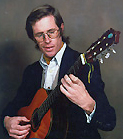 Hannemann’s Music Corner
Hannemann’s Music CornerIt’s time we learn music notation. Notation, in some form of representing sounds on paper, goes back as far as the Greeks. Notation has been described as a set of playing instructions, but it is much more than that.
Learning notation is learning musical literacy. Musical literacy serves the same function of linguistic literacy, allowing you to share thoughts and ideas and to communicate with others through music, just as linguistic literacy allows you to share thoughts and ideas and to communicate with others through words.
Notation tells you worlds about what is going on with the music. It tells you about melodic, harmonic, and rhythmic structure ─ about the interrelations of the musical elements. In so doing, it can teach you about music even as you are playing music.
Just as we learn “meaning from context” when we read and so expand our working knowledge of general and specific applications of written and spoken language, which we can then apply to our own usage, so, too, we can learn to expand our working knowledge of general and specific applications of music to our own usage by considering the context in which musical elements are used in the music we play.
By paying attention to what you play when you play it, you can essentially learn music, song writing, arranging, orchestration and composition from some of the best who have gone before.
Imagine being personally tutored by Mozart, Joplin, Gershwin, Rodrigo, W.C. Handy (blues), Berlin, The Beatles, and a host of others in every form of music. Everything they knew about music is in their scores and available to you to learn from via the commonality of notation.
Combining notation and ear-training allows one to simply look at a score and “hear” the music play much as one can read a book and “hear” the words spoken by the different characters.
Notation allows you to write down your own music in a way which will be meaningful to other musicians so that they can read and play the music of your own creation.
Sometimes, this is taught in reference to the black keys and white keys on the piano. While this gives people some form of a visual reference, I’m not convinced the approach is sound. (I couldn’t resist that one.)
Notation predates the piano by centuries and the piano is laid out according to notational practices, not the other way around. The most striking example of this is “middle c”. The tendency is to think the term refers to the “c” in the middle of the piano keyboard. But “middle c” is not in the middle of any other instrument. It is in the middle of the Grand Staff. The term comes from the location on the Grand Staff, not the location on the piano.
Guitar players, TAB is a cheat. It is a fingering chart, nothing more: to play guitar solely by TAB is less than a paint-by-numbers approach. Notation predates the guitar by more decades than it predates the piano and early guitarists didn’t use TAB. They used notation.
Which brings up a point about learning notation: many books, for a variety of instruments, will have a chart or diagram showing the fingerings for each note. Obviously, you need this. But generally, the diagram assumes notational literacy so you see the note on the staff, you see the fingering, but you don’t see the note name. The beginner then associates the picture with the fingering while skipping the step of naming the note.
So, we are going to start at the beginning – note recognition not by fingering but by name and octave placement. You will need a pad of staff paper (which you can make or get from Hannemann Music).
We’ll be doing basic fundamental stuff, but there is also notation which is specialized to various instruments. For this, there are several good books out there two of which are: Music Notation by Gardner Read, Taplinger Publishing (2nd Ed., 1979) and Essential Dictionary of Music Notation, by Tom Gerou and Linda Lusk, Alfred Publishing (Hannemann Music carries this one).
Welcome to the wonderful world of music.

